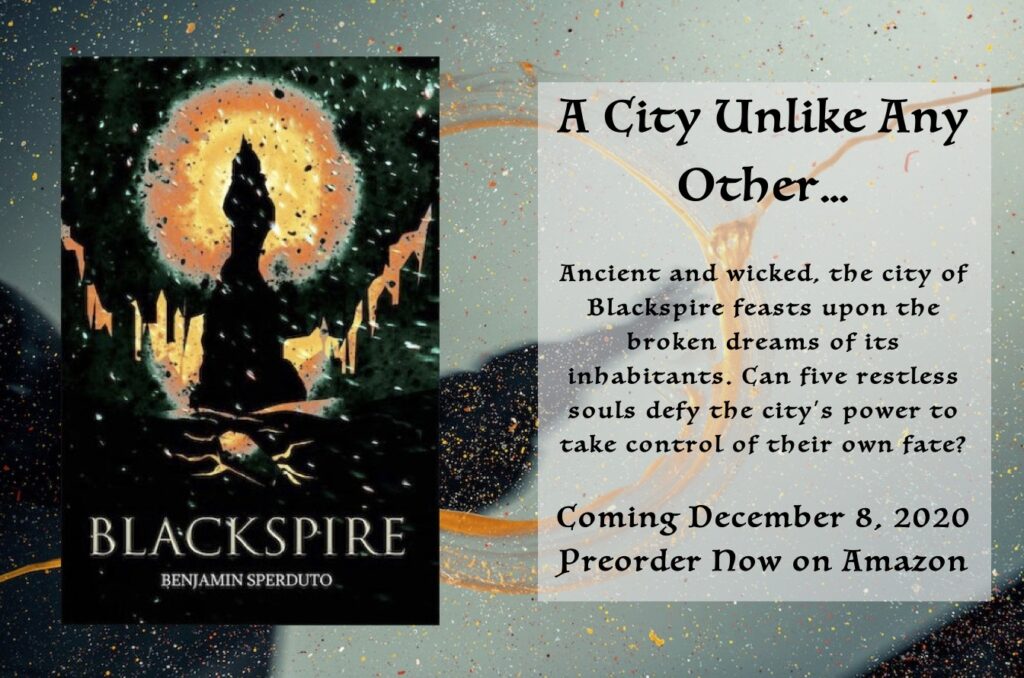So, what is Blackspire, exactly?
Describing this book has always been a bit of a challenge. In a broad sense, it’s a dark fantasy novel, it doesn’t neatly fit into any specific subcategory. The closest match is probably urban fantasy, but even there you’d have to add some qualifiers because the setting is very premodern. While the story is quite dark and gritty, I don’t know that it meets the criteria of the “grimdark” genre. And while it certainly has its fair share of bizarre elements, it may not be quite strange enough to fall within the “new weird” tradition.
All of this was by design, of course. When I set out to write Blackspire, I wanted to do something that felt different and unique. The end result is a rather atypical fantasy story that’s hard to categorize for marketing purposes, which certainly didn’t make it an easy story to pitch when the time came to find a home for it.
Origins of Blackspire
I started working on Blackspire around 2012 or 2013 shortly after I’d finished my first novel, The Walls of Dalgorod. As with most of my projects, it began with various concepts for characters and setting elements. I knew I wanted to do a story that took place entirely within a sprawling fantasy city. Part of that desire came from my fondness for the city of Sigil, the central location featured in the Dungeons & Dragons Planescape campaign setting. Sigil sits at the center of the infinite multiverse (yes, that contradiction is very intentional) and is so impossibly ancient that nobody knows its true origins or even much of its history. The city is run by various factions that function a bit like early modern confraternities, each one committed to a unique philosophy and constantly jockeying for power and influence.
Blackspire itself took shape quite early. I don’t quite remember where the name came from, but I’m pretty sure it was always tied to the idea of the giant black spire rising from the center of the city. While I wanted the city to feel very organic and grounded in some semblance of historical reality, the spire was the one fantasy element that loomed over everything else. Once I had that concept in place, I started sketching out ideas for different districts and neighborhoods.
My initial conception of the story was a bit more of a conventional fantasy tale. The main character was going to be an agent of the Margrave (the city’s highest political authority) who uncovered some dastardly plot against the city and engaged in various cloak and dagger activities to save the day.
Meh.
It all felt rather boring and predictable. After writing a fairly traditional fantasy novel, I wanted to do something different. Unfortunately, I didn’t really know how to do that until I read a book that would end up having a tremendous influence on my conception of the project.
China Miéville’s Perdido Street Station is probably the single biggest influence on Blackspire. The book showed me how to craft a fantasy story centered upon characters who didn’t feel like typical fantasy protagonists. They’re not heroes in the traditional sense, so they don’t run around solving problems with swords and sorcery. There’s a grounded realism to Miéville’s characters that helped me break away from archetypes that were probably too inspired by roleplaying games and action-adventure movies.
The other big influence was Miéville’s actual writing. He has a very evocative, highly literary style that differed immensely from the way I was writing at the time. In an effort to eliminate many of my bad writing habits, I’d been filtering pretty much everything I wrote through a Cormac McCarthy lens. Reading Miéville made me want to inject a little stylistic flourish into my writing, so I started by writing a short introductory passage to set the overall mood for Blackspire. That section eventually became the prologue of the final manuscript.
Writing Blackspire
Once I had a few characters in mind and a general sense of the setting, I did something that I never, ever, ever, ever do.
I just started writing.
Now, I know that may not sound like a bit deal for many writers, but I’m someone who typically doesn’t put a single word to paper before I know where the story is going. Starting a short story without a plan is one thing. You’ve only got 3,000-6,000 words to cover, so there’s a real limit to how far afield you can go before you have to wrap things up. It’s like driving to a place you’ve never been to, but it’s only a mile away from your house. When you’re writing a novel, though, there’s a lot that can go wrong over the course of 80,000-100,000 words (or closer to 180,000 in the case of Blackspire). It’s still like driving to a place you’ve never been to, only this time it’s a few hundred miles away and you don’t have a roadmap (and maybe in a country where the signs are in a different language).
Anyway, writing without an outline makes me anxious just thinking about it even now. And in this case, it created massive and entirely predictable problems. I got about five or six chapters into it before I had to stop and start sorting out what the hell was happening with the story. Multiple, disparate plot elements had been introduced and I didn’t have the faintest idea where most of them were going. It was a terrifying experience.
But…the chapters I’d written were good. Really good. I felt like it was some of the best writing I’d done up to that point. That ended up being really important because if I hadn’t felt so strongly about what I’d already written, I might have scrapped everything and started over rather than finding a way to make it all work.
And making it work was a big challenge. It ended up taking me about four years to finally finish Blackspire. I probably went through 25-30 different outlines before I eventually settled on something that worked. Of the novels I’ve completed, Blackspire was the most difficult by far. There were moments where I felt like I would be writing this book for the rest of my life, so completing it was a tremendous personal accomplishment!
Discover Blackspire
With the release date finally right around the corner, you’ll soon be able to explore the world of Blackspire for yourself. The team at Owl Hollow Press has helped to make it even better throughout the editing process, and I’m immensely pleased with the way the book finally came together. I can’t wait to share it with everyone!
I’m planning to write a couple more posts leading up to the December 8 release talking a bit about specific aspects of the book, so stay tuned for more details.

